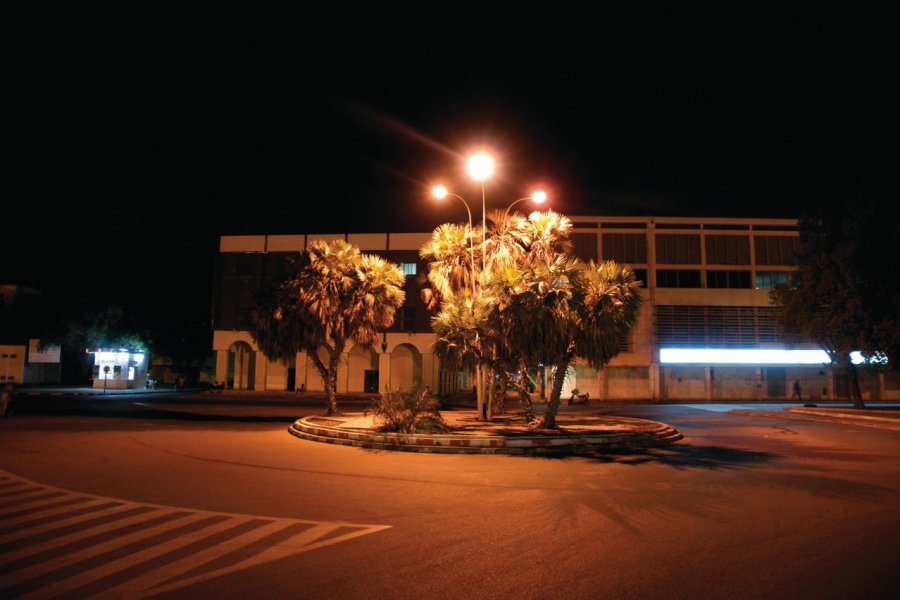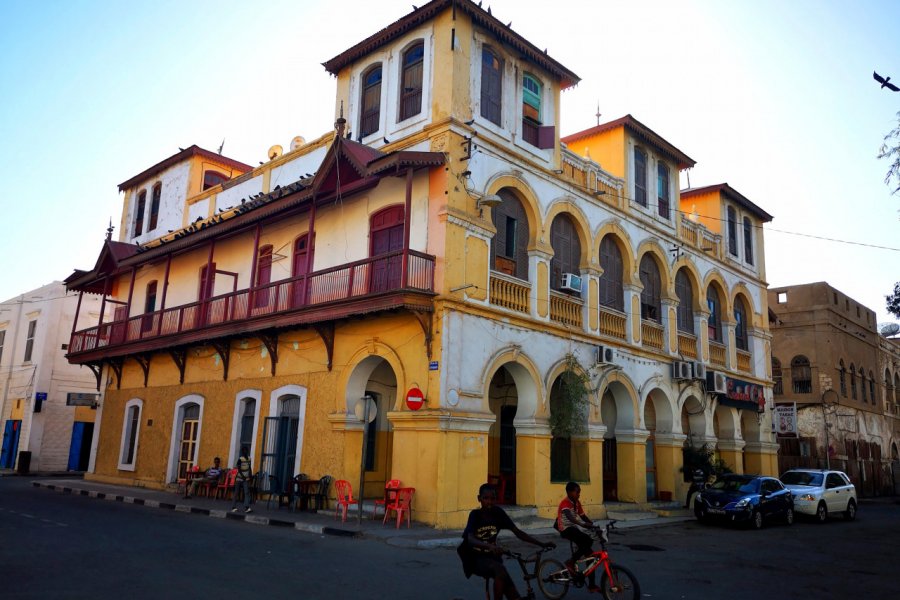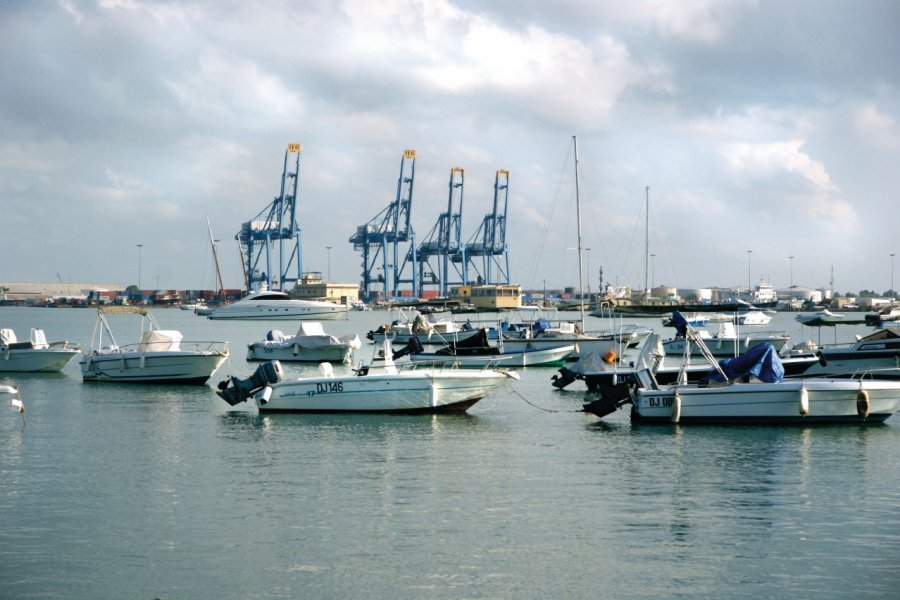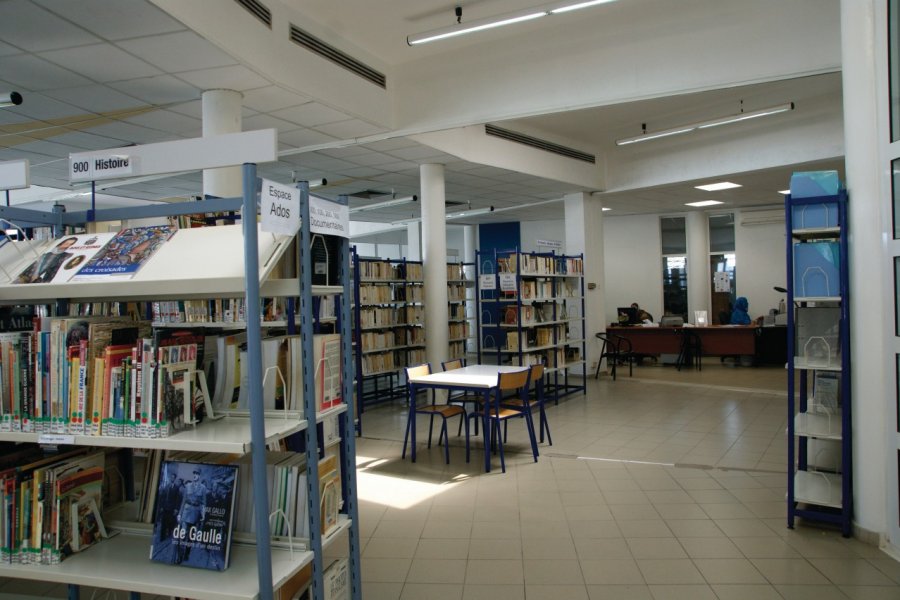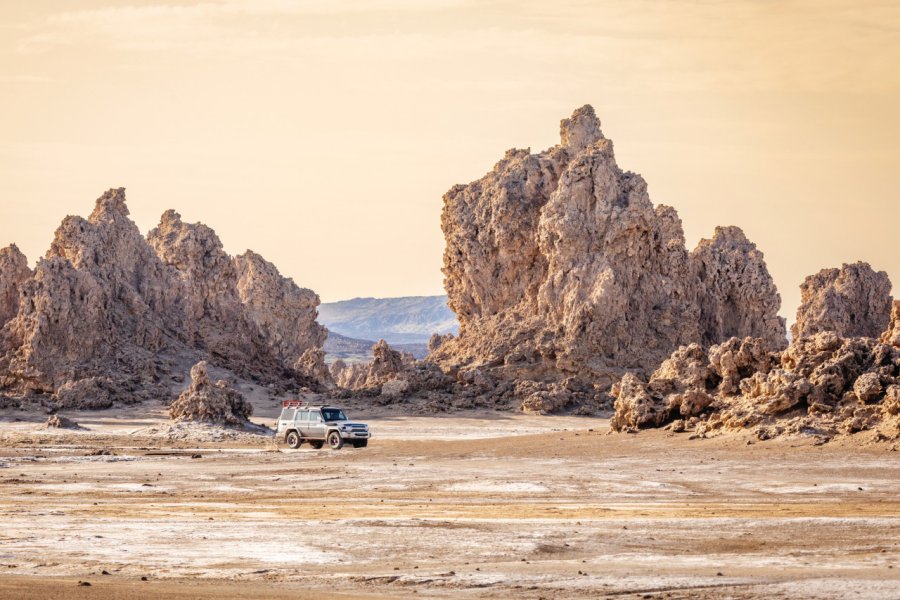Travel guide Djibouti
" This point was bought by France to the Sultan of Tadjoura. Exactly three rocks in the sea, with some pitfalls around but as he was, he had seduced France. She married her not for her beauty but for her background, a good background that would make a beautiful harbour. » Albert London, Pearl fishermen.
Djibouti has become a major port and a city very little oriented towards the sea. The capital of a country of nomads without beautiful buildings and museums. Here, on African soil, point of European architectural Evidence, Arab or Indian. Djibouti is neither Zanzibar nor Asmara. The city can charm its colonial district with the Moorish architecture, but it remains modest.
Djibouti's singularity is all in its unique atmosphere: white walls, horizontality buildings, colours and smells of the market, dynamism and doing a young nation. The small anchor has become an international port, attracting all kinds of people. The capital acts as a magnet on nomads from inland lands.
Djibouti, the Red Sea watch, fixes the French, American, Japanese and - soon - Chinese military (2017). Djibouti, the port, refuels sailors around the world and Ethiopian truckers. Djibouti, a peaceful country, welcomes refugees from neighbouring countries. Djibouti, the merchant, makes live Pakistani builders, Indian merchants or Senegalese fishermen, Vietnamese, Vietnamese, Greek, French or Lebanese fishermen or restaurateurs.
And each one of these places his little touch on this cosmopolitan city, where we're going to take a coffee-growing on a terrace before venturing into the maze of neighborhoods, lunch of an Ethiopian injera or a Yemeni moukbassa, between Africa, Europe and Arabia, which are the three faces of this city to the moving identity.
What to see, what to do Djibouti?
-
Book an activity
-
Customized travel
- Addresses to visit Djibouti
Weather at the moment
Suggested addresses Djibouti
Travel Djibouti
-
Find a hotel
-
Car Rental
-
International e-SIM package
-
Find a local agency
Amateurs de sensations uniques, privilégiez ces paysages qu’on ne rencontre nulle part ailleurs : le Goubet et ses îles volcaniques, les coulées de lave de l’Ardoukoba, la banquise de sel du lac Assal, l’étendue plate et sableuse du Grand Bara, le lac Abbé et ses paysages extraterrestres. Côté mer, les plongeurs découvriront des fonds sous-marins exceptionnels. Tout ici surprend par ses proportions et son abondance. Les sites restent préservés et peu fréquentés. Selon le temps et les moyens dont vous disposez, vous pouvez combiner les séjours courts décrits ci-dessous. Peu, très peu de gens partent seuls, et avec un petit budget. Le tourisme de découverte, en sac à dos, que l’on pratique si facilement en Ethiopie par exemple, est plus difficile à Djibouti. D’autant que pour atteindre les sites « principaux », aller à la découverte des régions plus reculées, et sortir des axes asphaltés, il vous faudra 4x4.
Find unique holiday offers with our partners
Discover Djibouti
Sitting down to a Yemeni-style grilled fish in the alleys of the African quarter, having a drink in the early evening in Menelik Square and experiencing the warm Djibouti nights, strolling through the souk, the district of the Flies, to discover the local atmosphere, going to watch the landings at the fishing port at sunrise, discovering the fine sandy beaches of the Musha Islands and exploring the underwater world are all invitations to soak up the unique atmosphere of Djibouti-City and its surroundings. This fascinating capital, home to two-thirds of the country's population, can be explored on foot, provided that you avoid the hottest hours (the city's rhythm is in tune with the seasonal temperatures). The city is not very seaside-oriented, but a few good addresses offer the possibility of enjoying the sea breeze and the beaches are not far away.
Pictures and images Djibouti
The 12 keywords Djibouti
1. Afars - Issas

The Afars and Issas are the two main groups making up Djibouti's population. The former live mainly in the north of the country, the latter in the south. They are found in Djibouti-Ville. Descended from the Cushitic peoples, Afars and Issas speak different languages of common origin and share the same religion.
2. Bab el-Mandeb
Gate of Lamentations or Gate of Tears, this is where the waters of the Red Sea and the Indian Ocean meet and clash. The Bab el-Mandeb Strait, which separates Djibouti and Yemen, is one of the world's busiest shipping lanes, and has always been and remains a highly strategic passageway.
3. Crows
Hated by some, adored by others, and not very shy, crows are numerous and noisy in Djibouti, especially in the capital. And the authorities have a hard time fighting against their proliferation. Much more pleasant to see and hear, parrots, parakeets and herons are also quite numerous in the city.
4. Daboïta
The daboïta (or daboyta) is the basic element of the Afar nomadic habitat. It is the ancestor of the igloo tent: the framework is obtained by criss-crossing branches and tying them together at each intersection with twine or plant fibers. The slightly ogival dome is covered with woven mats.
5. Khamsin

Sand wind blowing from North Africa and the Arabian Peninsula, with temperatures often in excess of 40°C. Supposed to blow for 50 days(Khamsin means "50" in Arabic), it gives the sky an ochre-orange hue. Its arrival, in June, is preceded by another wind, the sabo, which is also dry, but less scorching.
6. Monfreid
Many people are familiar with Djibouti and were inspired to visit after reading the accounts of Henry de Monfreid (1879-1974), adventurer, navigator, smuggler, photographer, painter and writer, encouraged by Kessel. No other foreigner has described this part of the world so well. Les Secrets de la mer Rouge is his first novel and bestseller (1914).
7. Qat
This plant, legally imported from Ethiopia, governs the daily life of Djiboutians. Euphoric, the fresh leaves, chewed for a long time, are mostly consumed in the afternoon, during mabraz, which plays an important social role. One sits down, discusses, smokes, drinks sodas, while "grazing" (a common term).
8. Rail
Inaugurated in 1917, the railroad linking Djibouti to Addis Ababa puts an end to centuries of caravan economy. The line, designed to carry passengers and freight, has been at a standstill since 2010, and resumed service in 2018. The train does not run at night. The journey between Djibouti and Addis Ababa is in two stages, with an overnight stay in Dire Dawa.
9. Whale shark
The whale shark, the largest fish in the world (up to 20 m long), is the star of the Gulf of Aden. Djibouti is one of the best places on the planet to see it, especially in Goubet. Nonchalant and harmless to humans, it feeds on plankton, algae and microscopic animals. The species is considered threatened.
10. RN1
Built in the mid-20th century, the N1 road links Djibouti to Addis Ababa. 80% of Ethiopia's imports come from this route. This asphalt road makes it easy to visit the south, despite the heavy truck traffic. It's the only road in the country where you have to overtake. All other roads are virtually deserted.
11. Afar Triangle
The Afar Triangle, or Afar Depression, is a vast triangular collapse zone stretching from Awash in Ethiopia to the Gulf of Tadjourah in Djibouti and the Dahlak Islands in Eritrea. The region is an open-air treatise on geology. It was studied by Haroun Tazieff as early as 1960, resulting in a book entitled L'Odeur du soufre.
12. Tukul

The French imported the term toukoul and used it to refer to any nomadic habitat on the continent. Toukoul and daboïta are two totally different dwellings. The toukoul is a circular wooden dwelling with a thatched roof, common in Ethiopia. Tourist camps are made up of daboïtas and toukouls.
You are from here, if...
Take the ferry across the Gulf of Tadjourah. It's a typical experience that offers a great spectacle (especially if the dolphins are out) along the way.
Taste the most popular Yemeni speciality in Djibouti: fish à la yéménite (makhbasa or moukbasa).
Spend some time in Place Menelik for a drink and to take the pulse of the city.
Take part in the mabraz. Created in the second half of the 20th century, these are discussion groups where everyone, regardless of social status, comes to talk about this changing country, its problems, what to say and what to do. All the while chewing qat for hours on end. The social role of these mabraz is essential. It was here, in the 1970s, that independence aspirations partly took shape. And even today, these spaces are the scene of discussions between various players in society.

